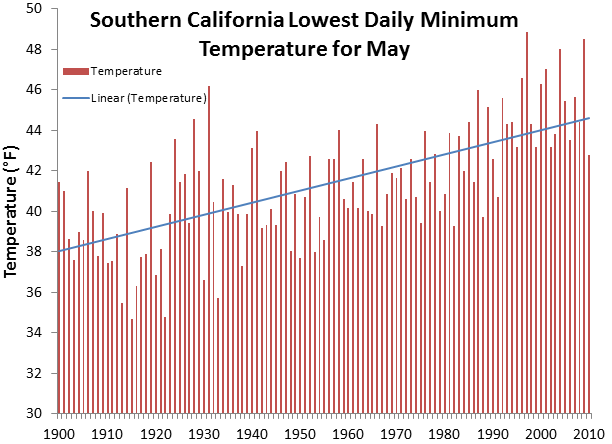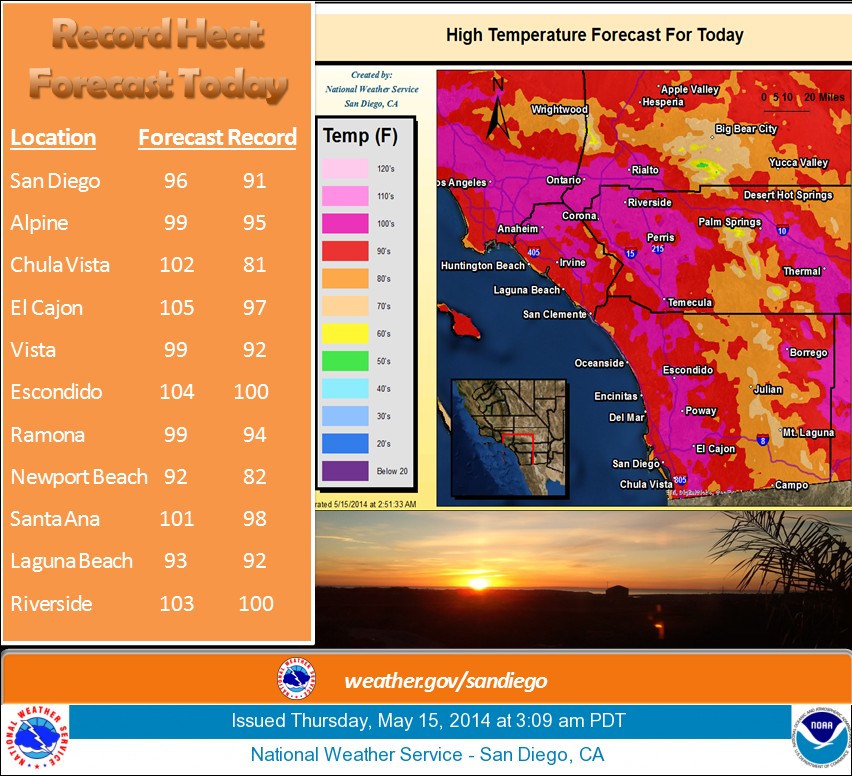The exceptional heat in Southern California and the dangerous wildfires occurring since May 13 may be a sign of climate change given their severity and timing. As of Friday, May 16, over 10,000 acres have burned throughout Southern California and several locations have surpassed previous temperature records.
The role of the Santa Ana winds
One factor key to both the heat and wildfires ravaging Southern California is the role of the Santa Ana winds. The Santa Ana is defined as strong, extremely dry winds in southwestern California that blow westward through the canyons toward the coast. It is the product of strong high pressure over the Great Basin and lower pressure along the coast. Usually it occurs during the fall and winter and tends to produce the warmest temperatures of the year.
The Santa Ana winds season is projected to expand into the dry season in the presence of climate change. This could mean more wildfires coupled with heat waves like those we are seeing now. However, the underlying mechanism of Santa Anas, which require the gradient caused by cooler desert temperatures in the high pressure system over the Great Basin and lower pressures in the warmer coastal areas might weaken as the land warms faster than the ocean as the planet continues to get warmer. Thus, Santa Anas may occur less often during the season as the difference in temperature between the land and the ocean grows.
Impact from California drought
While droughts naturally occur, the current, devastating drought in California is a bellwether of what we can expect to occur more often if current greenhouse emission rates are not reduced. Recent research shows that the prevalence and duration of droughts have increased in the last 100 years.
The progression of the California drought of 2014 has had an impact on the available fuel for the wildfires. Already this year, the 1400 wildfires starting in January is more than twice the amount that usually occurs, according to Cal Fire. Most of the state is in “extreme drought,” with 25 percent of California experiencing “exceptional drought” conditions. The California wet season spans the October-April period. Only 51 percent of average rainy season precipitation fell during this period. Compounding this impact is the statewide snowpack water content, which is at 18 percent of its normal level.
Droughts can be made worse by climate change because warmer air induces more evaporation, effectively desiccating the land. Longer-term droughts such as the one in California or Australia also create a dangerous feedback loop that makes heat waves more likely and more severe. A recent study, published in Nature, proposes that dry soil becomes even drier with initial heat and pumps more heat to the air above, sustaining higher temperatures for longer.
Trends in temperature extremes
The National Climate Assessment indicates that extreme heat has shown the biggest trend over the Southwestern U.S. Heat waves in the state of California since the year 2000 have shown clear upward trends for interior regions and along the coast. The clearest sign in these trends is the nighttime temperatures, which have risen, in unison, for a great majority of station observations throughout California.

Lowest daily temperature for the month of May for 1900-2010. Based on USHCN station observations with continuous, validated data for Pasadena, Paso Robles, Riverside, Santa Barbara, Ojai, San Bernardino.
The great heat waves of 2003 and 2006 were cataloged as “nighttime heat waves” in recent research. During these events, low temperatures were much warmer than average and unprecedented compared to previous events in the observational record. This is a dangerous component of the trends because it does not allow for a person to cool off after the heat of the day, putting many people without access to air conditioning in danger.
Just last year, a heat wave that started at the end of June broke multiple records across the Southwest U.S., making it the warmest day of any June in station observations. Heat extremes are also becoming more prevalent earlier in the year, as exemplified by May 2014 and in 2008. The extreme heat of May 2014 is doing the same for numerous locations in Southern California. The San Diego high temperature average is 68°F and it registered 97°F May 15 and this is the seventh record in the city this month alone. It also set a record high minimum temperature for the day at 70°F.
Climate change has played an important role in the lengthening of the wildfire season and this trend will continue in the future. A Cal Fire spokesman put it quite simple for the LA Times: the 2013 fire season rolled right into 2014.

